HIGH:
LOW:
VOLUME:
CHANGE:
Location
 |
The Gold Bull Mountain (Jinniushan) property is located in Yuanling County, Western Hunan Province, in the People's Republic of China. Situated along a large man-made hydroelectric reservoir, the project is accessible by road with telephone lines, cell-phone service, water, goods and services, and labor available nearby. The topography is hilly with elevations ranging from 92 to 232 m above sea level and with a sub-tropical climate, exploration and mining work can be conducted on a year-round basis. The famous Xiangxi Gold mine is located 6 kilometres South and is the oldest gold mine in the province having been in operation for over one hundred years.
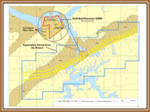 Click to Enlarge |
Ownership
In 2006, the Company's fully-licensed subsidiary, Yuanling Minco Mining Co., Ltd. (Yuanling Minco) acquired the GBM Mining License consisting of 0.178 km2 and the GBM Exploration Permit (16.78 km2) covering the area adjacent to the Mining License and a significant portion of the GBM gold mineralization belt in Yuanling county. Yuanling Minco owns 100% interest in both permits.
Background
The mining permit and on-strike portions of the exploration permit were actively mined for gold, both placer gold and hard rock mines, in the period before 1949 when communist China was established. Only on the mining permit area was this work well organized, although mine plans, surveys and production figures have been lost.
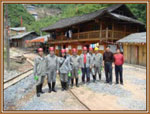 Click to Enlarge |
Before Minco's involvement, there was little organized exploration activity. No drilling or other modern exploration techniques (geochemistry, geophysics, etc.) have ever been undertaken in the area. Tracked mining using open-stope methods took place at a rate of a few tonnes per day on the mining permit and have occurred to a lesser extent at other locations on the exploration permit. Prior engineering and geological control and proper documentation of the mining works are unknown. Ore processing consisted of small electric crushers, gravity separation, cyanidation in concrete ponds, and some amalgamation by mercury. The processing machinery has been removed, leaving crude foundations behind. In 1993, the local hydroelectric dam was completed and some of the historical mining areas were flooded.
The exploration permit surrounding the mining permit contains numerous historical artisanal mine workings including trenches and at least 17 small mine adits over a strike length of approximately 6 km. The GBM gold belt extends for more than 15 kilometers.
Geology and Mineralization
Regional and Local Geology
The area of interest occurs within Paleozoic rocks of the South China Plate in unconformable and faulted contact with younger Cretaceous sediments. A strong element of NW-SE compression is evident with abundant NE-SW fold axes and reverse faults striking in the same direction.
The geology of the region is divided into low-grade metamorphically altered:
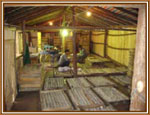 Click to Enlarge |
Property Geology
Predominantly shear-hosted gold-quartz mineralization occurs in Proterozoic sandstones, and shales, which have undergone NW-SE compression. The Proterozoic sequence is unconformably overlain by Cretaceous to Tertiary purplish sandy sediments and forms the central unit of a NE-SW trending anticline. The southern contact between the two formations has been mapped as a thrust fault. Gold mineralization is associated with brittle-ductile shears with a reverse sense of movement similar in form to the mapped thrust fault. Shallow dipping tension veins splay off the shear veins, usually in the footwall.
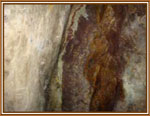 Click to Enlarge |
The gold-quartz mineralization seen so far is entirely structurally controlled and the mineralizing fluids have barely affected the wall rocks. The veins contain few examples of open space filling but rather appear to be of a deeply seated type containing ribbon structures consisting of alternating bands of country rock and vein quartz. It appears that the shearing event within which the quartz veins were emplaced continued after the main mineralizing event to form re-sheared and brecciated veins. Minor iron carbonate and sericitic wall rock alteration have been noted.
The central part of the mine is developed on at least three separate, but related shear veins across a horizontal width of about 60 metres. The strike length of the main portion of the mine is about 350 metres. Where shear veins come close together, the intervening space can become riddled with tension veins leading to the supposition that there may be sections of the mine where the narrow-vein, open-stope mining utilized in the past may be replaced by larger scale mining techniques.
Nugget Effect
 |
There is a significant "Nugget Effect" within the assay distribution requiring careful sampling and assaying techniques. Coarse gold within samples, a problem often encountered in gold mining, makes it very difficult to reproduce results.
Samples have been analyzed by "metallic screen analysis" and fire assay, which is considered to be the most accurate assay method for samples of this nature. In this technique, samples are pulverized and pass through a mesh screen. The fine fraction and coarse fraction are fire assayed separately and the results are combined.
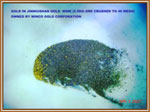 Click to Enlarge |
In cases such as this, drilling can be used to define the geometry of the various veins while cross cutting and drifting provide a more accurate representation of the mineralized zones.
For detailed project information, please refer to the Technical Report on the Gold Bull Mountain Project dated December 28, 2006, Author: Peter G. Folk, P. Eng.
Results
The exploration team has completed detailed geological mapping conducted over both the exploration (12.53 km2) and mining licence (0.178 km2) areas in preparation for ongoing surveys.
Minco reported its first set of channel sample results in early February, 2007. 71 channel samples were collected from four individual zones and with an overall average grade of 9.87 g/t gold and average width of 0.7 metres.
The average gold grade and thickness for 3 zones are as follows:
| Zone | Average Grade (g/t) | Thickness (m) |
| V2-1 | 6.87 | 0.65 |
| V2-2 | 22.68 | 1.06 |
| V2-3 | 18.78 | 0.77 |
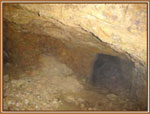 Click to Enlarge |